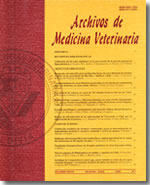Somatic cell count and composition of dairy goat milk according to milk yield and lactation period under intensive management system, in the central region of Chile
Main Article Content
Abstract
The aim of this study was to characterize milk yield, somatic cell count (SCC) and solids in goat milk according to level of milk yield and lactation period in an intensive dairy goat system. Twenty-five Saanen goats of parity 2, managed under the same conditions, were studied. Goats were assigned into two groups. Group A was defined as low milk yield (< 450 L/lactation) and Group B as high milk yield (> 550 L/lactation). Once a month, a milk yield control was conducted during the two milking periods. A milk sample was taken once a day during 10 months. Total protein, fat and lactose were assessed using a Milkoscan 133B. Somatic cell counts were determined using a Fossomatic 90. The outcome variables were compared between groups A and B. Results were analyzed by ANOVA and least square means were compared by Tuckey-test (P ≤ 0.05). Groups A and B produced 346 ± 64.9 L and 703 ± 209 L of milk, respectively. The average milk production by lactation period was similar for both groups. The highest levels of milk yield were reached between the second and fourth month of lactation. There was a tendency to higher levels of SCC in group B, however values remained within the normal levels reported in other studies. Milk fat, protein and total solids followed an inverse pattern in relation to the curve of milk yield. Lactose was stable through the entire lactation. Correlation between SCC and milk yield was moderate and negative. There was no relationship between SCC and milk solids. Milk yield and solids (protein and fat) had moderate and negative correlations.

